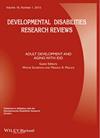Grayson N. Holmbeck, Katie A. Devine
{"title":"脊柱裂的社会心理和家庭功能","authors":"Grayson N. Holmbeck, Katie A. Devine","doi":"10.1002/ddrr.90","DOIUrl":null,"url":null,"abstract":"<p>A developmentally oriented bio-neuropsychosocial model is introduced to explain the variation in family functioning and psychosocial adjustment in youth and young adults with spina bifida (SB). Research on the family functioning and psychosocial adjustment of individuals with SB is reviewed. The findings of past research on families of youth with SB support a resilience–disruption view of family functioning. That is, the presence of a child with SB disrupts normative family functioning but many families adapt to such disruption and exhibit considerable resilience in the face of adversity. Parents of youth with SB, and particularly those from lower socio-economic status (SES) homes, are at-risk for psychosocial difficulties. Individuals with SB are at-risk for developing internalizing symptoms, attention problems, educational difficulties, social maladjustment, and delays in the development of independent functioning. Emerging adults are often delayed in achieving milestones related to this stage of development (e.g., vocational and educational achievements). Methodologically sound, longitudinal, and theory-driven studies of family and psychosocial functioning are needed, as are randomized family-based intervention trials, to promote adaptive functioning and better psychosocial outcomes in families of individuals with SB. © 2010 Wiley-Liss, Inc. Dev Disabil Res Rev 2010;16:40–46.</p>","PeriodicalId":55176,"journal":{"name":"Developmental Disabilities Research Reviews","volume":"16 1","pages":"40-46"},"PeriodicalIF":0.0000,"publicationDate":"2010-04-20","publicationTypes":"Journal Article","fieldsOfStudy":null,"isOpenAccess":false,"openAccessPdf":"https://sci-hub-pdf.com/10.1002/ddrr.90","citationCount":"116","resultStr":"{\"title\":\"Psychosocial and family functioning in spina bifida\",\"authors\":\"Grayson N. Holmbeck, Katie A. Devine\",\"doi\":\"10.1002/ddrr.90\",\"DOIUrl\":null,\"url\":null,\"abstract\":\"<p>A developmentally oriented bio-neuropsychosocial model is introduced to explain the variation in family functioning and psychosocial adjustment in youth and young adults with spina bifida (SB). Research on the family functioning and psychosocial adjustment of individuals with SB is reviewed. The findings of past research on families of youth with SB support a resilience–disruption view of family functioning. That is, the presence of a child with SB disrupts normative family functioning but many families adapt to such disruption and exhibit considerable resilience in the face of adversity. Parents of youth with SB, and particularly those from lower socio-economic status (SES) homes, are at-risk for psychosocial difficulties. Individuals with SB are at-risk for developing internalizing symptoms, attention problems, educational difficulties, social maladjustment, and delays in the development of independent functioning. Emerging adults are often delayed in achieving milestones related to this stage of development (e.g., vocational and educational achievements). Methodologically sound, longitudinal, and theory-driven studies of family and psychosocial functioning are needed, as are randomized family-based intervention trials, to promote adaptive functioning and better psychosocial outcomes in families of individuals with SB. © 2010 Wiley-Liss, Inc. Dev Disabil Res Rev 2010;16:40–46.</p>\",\"PeriodicalId\":55176,\"journal\":{\"name\":\"Developmental Disabilities Research Reviews\",\"volume\":\"16 1\",\"pages\":\"40-46\"},\"PeriodicalIF\":0.0000,\"publicationDate\":\"2010-04-20\",\"publicationTypes\":\"Journal Article\",\"fieldsOfStudy\":null,\"isOpenAccess\":false,\"openAccessPdf\":\"https://sci-hub-pdf.com/10.1002/ddrr.90\",\"citationCount\":\"116\",\"resultStr\":null,\"platform\":\"Semanticscholar\",\"paperid\":null,\"PeriodicalName\":\"Developmental Disabilities Research Reviews\",\"FirstCategoryId\":\"1085\",\"ListUrlMain\":\"https://onlinelibrary.wiley.com/doi/10.1002/ddrr.90\",\"RegionNum\":0,\"RegionCategory\":null,\"ArticlePicture\":[],\"TitleCN\":null,\"AbstractTextCN\":null,\"PMCID\":null,\"EPubDate\":\"\",\"PubModel\":\"\",\"JCR\":\"\",\"JCRName\":\"\",\"Score\":null,\"Total\":0}","platform":"Semanticscholar","paperid":null,"PeriodicalName":"Developmental Disabilities Research Reviews","FirstCategoryId":"1085","ListUrlMain":"https://onlinelibrary.wiley.com/doi/10.1002/ddrr.90","RegionNum":0,"RegionCategory":null,"ArticlePicture":[],"TitleCN":null,"AbstractTextCN":null,"PMCID":null,"EPubDate":"","PubModel":"","JCR":"","JCRName":"","Score":null,"Total":0}
引用次数: 116


 求助内容:
求助内容: 应助结果提醒方式:
应助结果提醒方式:


